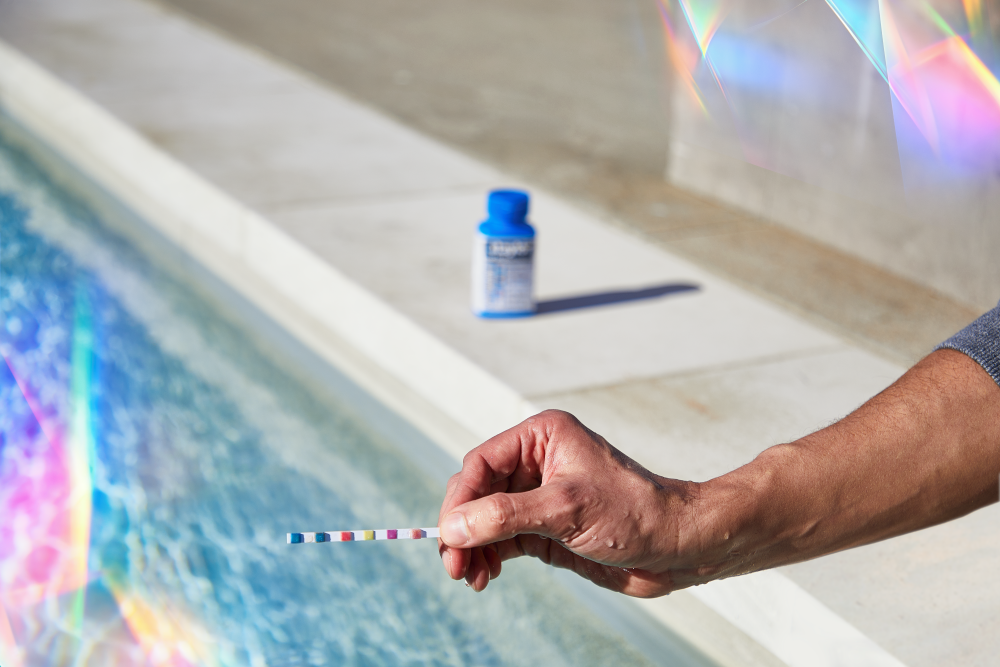Following these simple best practices when testing pool and spa water samples will help ensure the most accurate results.
Start the swim season with fresh reagents
Reagents are perishable. Just like a head of lettuce or the pills in your medicine cabinet, the chemicals in a test kit (or on a test strip pad) will degrade over time, even under optimum conditions. The process of deterioration speeds up when storage conditions are less than ideal. Extremes of heat and cold, as well as prolonged exposure to air, sunlight, humidity, moisture, and/or treatment chemicals can diminish your reagents’ useful life. You won't get accurate readings with deteriorated reagents or with stained test cells or faded color standards. So, start a new season by examining your tools. Make sure reagents are fresh and replace any missing instructions along with broken, faded, or stained equipment.
Never interchange products from different manufacturers
Test kit components from different manufacturers are not interchangeable. Each manufacturer makes its reagents in different concentrations. Their color standards are developed for specific reagent concentrations and the view depths of test cells are also highly specific. You also should not assume you can interchange products within one manufacturer’s product lines. For instance, Taylor produces several different phenol red solutions for pH testing and a different type of color comparator is used with each. However, note that the exception is that DPD liquids and tablets can be interchanged in most visual color-matching chlorine/bromine tests.
Read the manufacturer’s instructions carefully before beginning a test
Not only are each manufacturer's tests different, sometimes manufacturers change a procedure. Take test strips for example. To get the proper exposure of reagent to water chemistry, you can be instructed to dip quickly, swirl the pads for a specified number of times, or swish the strip back and forth. If you dip when you should swish, color development will be compromised. If the wait times to observe between readings have changed and you're unaware, you will also get unreliable results. No matter how many times you've performed a test, it's always best to have the manufacturer's instructions on hand to review your testing procedures.
Follow the manufacturer’s instructions precisely
Water tests are like recipes. When a chemist develops a test procedure, everything is carefully calibrated to work together to give you an accurate reading — from the sample size, to the amount of reagent dispensed, to the way in which the chemicals are combined with the water sample, to the timing between each step of the procedure. If the instruction says to crush the tablet then stir until it's completely dissolved, you must do this or the reaction will be incomplete. If you're supposed to swirl after each drop and you shake the sample instead, you could alter the pH and alkalinity. Bottom line: failure to follow the instructions exactly will result in an inaccurate reading. In turn, an inaccurate reading will result in underdosing or overdosing the chemical treatment… or you may not even be aware treatment is required.
Take a water sample that accurately represents the pool
It’s important for water samples to be representative of the entire pool as a whole. For instance, water chemistry at the surface of the pool is not typical. Surface water interacts with air chemistry, evaporation is taking place, and it's where oils and debris float. Water chemistry near a return line, makeup water inlet, or chemical feeders is not typical because treatment chemical concentrations are different in these locations than in the pool at large. Water drawn from steps or corner locations may not have experienced the same circulation action open areas have. To get a representative sample, take the water from mid-pool or test at both the shallow end and deep end and then average the results. Take your sample from at least elbow depth where sunlight cannot penetrate (about 18”). Test the sample immediately so that its characteristics do not have time to change.
Conduct color-matching in natural daylight
It’s a fact that colors look different depending on the type of lighting they’re in. The term for this phenomenon is metamerism. Different light sources make different colors. If a test is designed to be read in daylight — after all, pools are mostly outdoors — artificial lighting (incandescent, fluorescent, halogen, LED) will affect your color perception. Sunglasses do too, so remove them before comparing colors. It’s also important not to be looking directly into the sun when matching colors outdoors.
Other best practices to keep in mind include keeping chemicals away from kids and pets; not using glass containers that could shatter to collect sample water; tightly capping reagent bottles to prevent contamination and never interchanging caps; and washing out any residue from the test cell and wiping up spills promptly to prevent stains from setting in or cross-contamination of tests.

